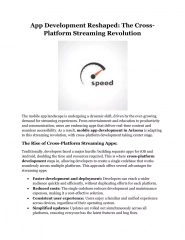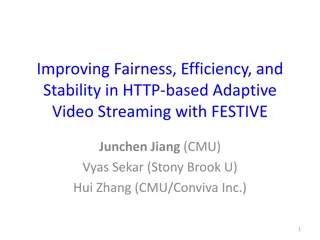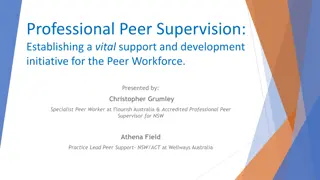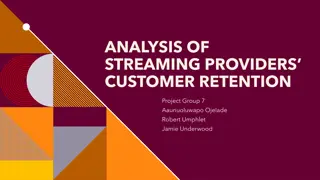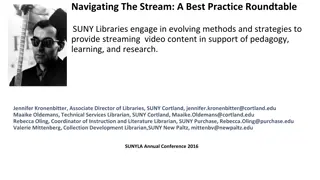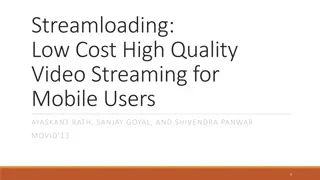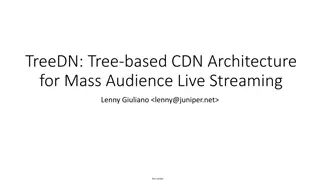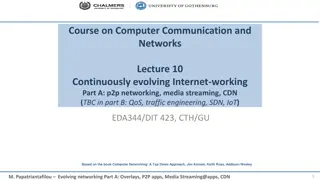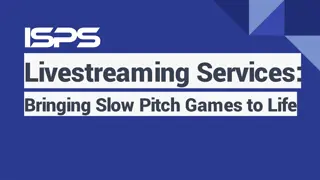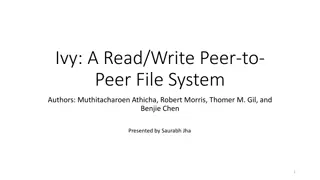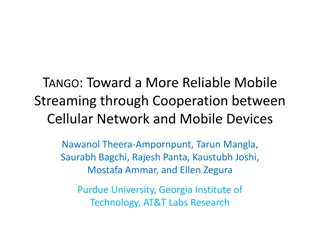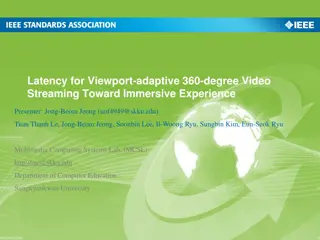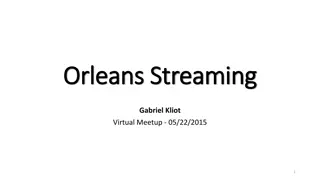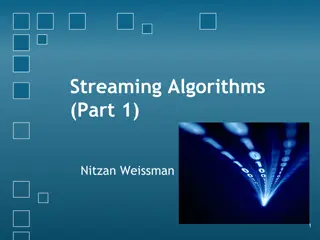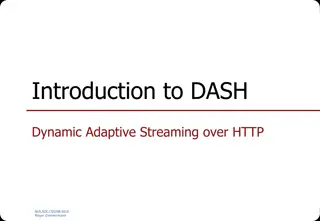
Peer-to-Peer Streaming Overview: Challenges and Solutions
Delve into the realm of Peer-to-Peer Streaming with insights on application-level multicast, end-host forwarding, issues faced, and innovative solutions like CoopNet and Smart Splitting. Explore concepts such as splitting video into parts, multiple description coding, and layered coding to enhance streaming efficiency and quality.
Download Presentation

Please find below an Image/Link to download the presentation.
The content on the website is provided AS IS for your information and personal use only. It may not be sold, licensed, or shared on other websites without obtaining consent from the author. If you encounter any issues during the download, it is possible that the publisher has removed the file from their server.
You are allowed to download the files provided on this website for personal or commercial use, subject to the condition that they are used lawfully. All files are the property of their respective owners.
The content on the website is provided AS IS for your information and personal use only. It may not be sold, licensed, or shared on other websites without obtaining consent from the author.
E N D
Presentation Transcript
Peer-to-Peer Streaming NUS.SOC.CS5248-2012 Roger Zimmermann (based in part on slides by Ooi Wei Tsang)
Peer-to-Peer Streaming A type of application-level multicast But packets are forwarded by end- host (not proxies) NUS.SOC.CS5248-2012 Roger Zimmermann (based in part on slides by Ooi Wei Tsang)
Peer-to-Peer Streaming ALM with end-hosts as forwarders End Host Video Server Overlay Links S NUS.SOC.CS5248-2012 Roger Zimmermann (based in part on slides by Ooi Wei Tsang)
Issues with P2P Streaming Depends on peers to forward packets, but peers can fail/leave anytime S NUS.SOC.CS5248-2012 Roger Zimmermann (based in part on slides by Ooi Wei Tsang)
CoopNet Resilient Peer-to-Peer Streaming, V. Padmanabhan et. al. ICNP 2003 NUS.SOC.CS5248-2012 Roger Zimmermann (based in part on slides by Ooi Wei Tsang)
Idea Split video into k parts , send one part along one tree NUS.SOC.CS5248-2012 Roger Zimmermann (based in part on slides by Ooi Wei Tsang)
Smart Splitting A node may be able to reconstruct partial data with a subset of the parts More parts, better quality Multiple Description Coding NUS.SOC.CS5248-2012 Roger Zimmermann (based in part on slides by Ooi Wei Tsang)
Simple Example (Video) Divide into two descriptions 1. Even frames 2. Odd frames Multiple State Encoding Does not scale to a large number of descriptions NUS.SOC.CS5248-2012 Roger Zimmermann (based in part on slides by Ooi Wei Tsang)
Layered Coding Layer 1 Layer 2 Layer 3 NUS.SOC.CS5248-2012 Roger Zimmermann (based in part on slides by Ooi Wei Tsang)
Layered Coding One layer one description? But there are dependencies between the descriptions NUS.SOC.CS5248-2012 Roger Zimmermann (based in part on slides by Ooi Wei Tsang)
Multiple Description Coding D1 L1 L2.1 L3.1 D2 L1 L2.2 L3.2 L2.1 XOR L2.2 L1 L3.3 D3 NUS.SOC.CS5248-2012 Roger Zimmermann (based in part on slides by Ooi Wei Tsang)
Multiple Description Coding D1 L1 L2.1 L2.2 L2.3 L3.1 D2 L1 L2.3 L2.4 L2.1 L3.2 D3 L1 L2.1 L2.2 L2.4 L3.3 D4 L1 L2.3 L2.4 L2.2 XOR NUS.SOC.CS5248-2012 Roger Zimmermann (based in part on slides by Ooi Wei Tsang)
How to Build Tree? Send one description along one tree only A node is internal node in at most one tree, and is leaf node in the rest of the trees NUS.SOC.CS5248-2012 Roger Zimmermann (based in part on slides by Ooi Wei Tsang)
Example R R 3 4 1 2 2 4 5 6 1 3 5 6 NUS.SOC.CS5248-2012 Roger Zimmermann (based in part on slides by Ooi Wei Tsang)
Tree Maintenance The source of video maintains all states. Isn t this a centralized design that is not robust? NUS.SOC.CS5248-2012 Roger Zimmermann (based in part on slides by Ooi Wei Tsang)
Node Join Becomes internal node in a tree with least number of internal nodes. Becomes leaf node in the rest of the trees. NUS.SOC.CS5248-2012 Roger Zimmermann (based in part on slides by Ooi Wei Tsang)
To join as internal node Pick highest internal node with enough bandwidth as parent. If cannot find, pick internal node with leaf node as child, preempt the leaf node. NUS.SOC.CS5248-2012 Roger Zimmermann (based in part on slides by Ooi Wei Tsang)
To join as leaf node Pick highest internal node with enough bandwidth as parent. If cannot find, migrate an internal node from another tree. NUS.SOC.CS5248-2012 Roger Zimmermann (based in part on slides by Ooi Wei Tsang)
Network Efficiency When choosing parents, breaks ties by choosing closer node as parents. NUS.SOC.CS5248-2012 Roger Zimmermann (based in part on slides by Ooi Wei Tsang)
Effects of Number of Trees NUS.SOC.CS5248-2012 Roger Zimmermann (based in part on slides by Ooi Wei Tsang)
Effects of Number of Trees NUS.SOC.CS5248-2012 Roger Zimmermann (based in part on slides by Ooi Wei Tsang)
MDC versus FEC NUS.SOC.CS5248-2012 Roger Zimmermann (based in part on slides by Ooi Wei Tsang)
Summary of CoopNet Robustness through redundancy in coding network paths NUS.SOC.CS5248-2012 Roger Zimmermann (based in part on slides by Ooi Wei Tsang)
Issues with P2P Streaming Not all peers are happy to contribute resources selfish peers exist. S NUS.SOC.CS5248-2012 Roger Zimmermann (based in part on slides by Ooi Wei Tsang)
Deter Selfish Peers Add a constraint: A peer can only receive at most as much as it is willing to send S/R >= 1 NUS.SOC.CS5248-2012 Roger Zimmermann (based in part on slides by Ooi Wei Tsang)
Practical Issues Asymmetric Links Different downlink capacity NUS.SOC.CS5248-2012 Roger Zimmermann (based in part on slides by Ooi Wei Tsang)
Dagster Contributor Aware P2P Streaming in Heterogeneous Environment MMCN 2005 NUS.SOC.CS5248-2012 Roger Zimmermann (based in part on slides by Ooi Wei Tsang)
Goals Robustness wrt transient peers Deter selfish users without restricting S:R ratio Heterogeneous receivers NUS.SOC.CS5248-2012 Roger Zimmermann (based in part on slides by Ooi Wei Tsang)
Issue 1 Heterogeneous receivers Solution: Transcoding NUS.SOC.CS5248-2012 Roger Zimmermann (based in part on slides by Ooi Wei Tsang)
Transcoding D A C E S F B NUS.SOC.CS5248-2012 Roger Zimmermann (based in part on slides by Ooi Wei Tsang)
Issue 2 Improve Robustness Solution: Distributed Streaming NUS.SOC.CS5248-2012 Roger Zimmermann (based in part on slides by Ooi Wei Tsang)
Distributed Streaming D A C E S F B NUS.SOC.CS5248-2012 Roger Zimmermann (based in part on slides by Ooi Wei Tsang)
Multiple State Encoding D 1,3,5.. A C E S F B NUS.SOC.CS5248-2012 Roger Zimmermann (based in part on slides by Ooi Wei Tsang)
Issue 3 Provide incentives without constraining S:R ratio? Solution: give peers that pledge more contributions some benefits contributor-aware NUS.SOC.CS5248-2012 Roger Zimmermann (based in part on slides by Ooi Wei Tsang)
Providing Incentives Idea: allow a peer to preempt another peer with smaller contributions Benefits Lower rejection rate Closer to source NUS.SOC.CS5248-2012 Roger Zimmermann (based in part on slides by Ooi Wei Tsang)
DAG Construction NUS.SOC.CS5248-2012 Roger Zimmermann (based in part on slides by Ooi Wei Tsang)
Example 15:5 A 0:30 S 15:5 B NUS.SOC.CS5248-2012 Roger Zimmermann (based in part on slides by Ooi Wei Tsang)
Example 15:5 A 0:30 S 15:5 B NUS.SOC.CS5248-2012 Roger Zimmermann (based in part on slides by Ooi Wei Tsang)
Example 15:5 A 0:30 S 15:15 15:5 B C NUS.SOC.CS5248-2012 Roger Zimmermann (based in part on slides by Ooi Wei Tsang)
Example: Preemption 15:5 A 0:30 S 15:15 15:5 C B NUS.SOC.CS5248-2012 Roger Zimmermann (based in part on slides by Ooi Wei Tsang)
Example: Rejection 15:5 A 0:30 S 15:5 15:6 B D NUS.SOC.CS5248-2012 Roger Zimmermann (based in part on slides by Ooi Wei Tsang)
Preemption Rules A can preempt B if A is willing to donate more than B B can find new parents after preemption NUS.SOC.CS5248-2012 Roger Zimmermann (based in part on slides by Ooi Wei Tsang)
Example 15:5 A 0:30 S 10:5 15:5 B E NUS.SOC.CS5248-2012 Roger Zimmermann (based in part on slides by Ooi Wei Tsang)
Example 15:5 A 0:30 10:5 S E 15:5 B NUS.SOC.CS5248-2012 Roger Zimmermann (based in part on slides by Ooi Wei Tsang)
Example 15:5 2:1 A F 0:30 S 10:5 15:5 2:1 B H G NUS.SOC.CS5248-2012 Roger Zimmermann (based in part on slides by Ooi Wei Tsang)
Example: 2 Preemptions 15:5 2:1 A F 0:30 10:5 S G 15:5 2:1 B H NUS.SOC.CS5248-2012 Roger Zimmermann (based in part on slides by Ooi Wei Tsang)
Details Centralized control at the server to prevent illegal preemption NUS.SOC.CS5248-2012 Roger Zimmermann (based in part on slides by Ooi Wei Tsang)
Details Minimize number of descendents affected when preempting peers Find a subset of children to preempt, such that number of descendents affected is minimized, and preempted bandwidth is enough for the new node. KNAPSACK problem! NUS.SOC.CS5248-2012 Roger Zimmermann (based in part on slides by Ooi Wei Tsang)
Details Prefer parents who are closer to the source and have large contributions NUS.SOC.CS5248-2012 Roger Zimmermann (based in part on slides by Ooi Wei Tsang)
Details Peers can cheat by pledging more contributions than they are capable of. We can only do our best to detect such cheaters :-( NUS.SOC.CS5248-2012 Roger Zimmermann (based in parton slides by Ooi Wei Tsang)

